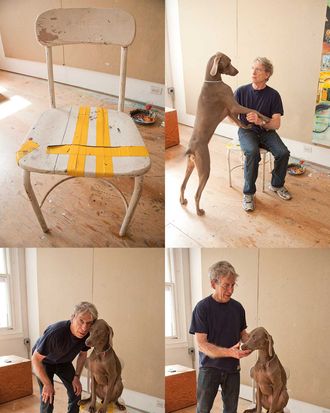
By far the most clamorous reception I encountered was at the home and studio of William Wegman, from his three Weimaraners ÔÇö Candy, Bobbin, and Flo. Wegman is widely known for the photographs, films, and videos he stages of his gray-furred clan. This three-decade story began with WegmanÔÇÖs legendary Man Ray. Fay Ray succeeded his reign in 1986, as later did her offspring, and theirs in turn. Flo, pictured here, arrived in March of 2011, and Topper in May, shortly after my visit.
Appearances over the years have included┬áThe Tonight Show┬áand┬áLate Night With David Letterman, and Wegman has created film and video works for┬áSaturday Night Live, Nickelodeon, and┬áSesame Street. Wegman has also produced a series of childrenÔÇÖs books (including┬áLittle Red Riding Hood,┬áMother Goose, and┬áChip Wants a Dog) and many others for adult readership.
ÔÇ£I was so excited to see that chair,ÔÇØ Wegman said of the object that had facilitated our meeting. I had first heard about the chair during my┬ávisit with Analia Saban in Santa Monica, who informed me that Wegman ÔÇö and subsequently John Baldessari ÔÇö had lived and worked in the studio she now inhabits. The chair had been left behind until 2011, when Wegman had dropped by SabanÔÇÖs place and had been reunited with his beloved object.
This particular chair was one of five that often had been used in his practice; one of this style can be seen, just barely, in┬áStomach Song. In that 1970 video, a shirtless Wegman, framed from the neck down, contorts his torso into a face that hums a hilarious tune. One of the chairÔÇÖs brethren, a metal one, was the subject of WegmanÔÇÖs┬áMassage Chair (1972ÔÇô73), in which he parodies an infomercial for a massage chair, beating the side of it with a stick.
Since Wegman and this particular chair had last partnered, it had been painted white (possibly during BaldessariÔÇÖs tenure at the studio) and repaired by Saban with yellow duct tape. Saban had shipped it back to Wegman a few months before my visit.
Flo and Wegman had given the chair a test run. As if born to it, Flo had climbed on it to strike a pose. Wegman told me a bit about the dogsÔÇÖ assimilation process:
From the beginning with Man Ray, there would be nobody else in the room. IÔÇÖd be talking to him. The camera would be here. He would look over to check. ItÔÇÖs apparent when you see the videos, in┬áSpelling Lesson (1973ÔÇô74), where IÔÇÖm asking him, ÔÇ£Do you want to go to the beach?ÔÇØ He looks into the camera, saying, Oh, I see, weÔÇÖre doing one of those, and then rolls his eyes.
TheyÔÇÖve come to like it. I make it so itÔÇÖs not about treats but just a normal thing that they do, and thatÔÇÖs what I enjoy. I like to see how different each dog might be. Some are helpful; others are sleepy; some are in between. When I was training Flo, I put her next to the dog I was working on, so she would think she was working. SheÔÇÖd get used to the lights and the fact that this was a studio situation. I would put her on a pedestal next to the dog who was in the scene, because when I wasnÔÇÖt putting her in, she would rush in and kind of screw it up. When they donÔÇÖt want to do it, they let you know, too. My second dog, Fay, would act very heavy. SheÔÇÖd get flat on the floor, so sheÔÇÖd be very heavy to pick up. It would add 30 pounds to her weight.
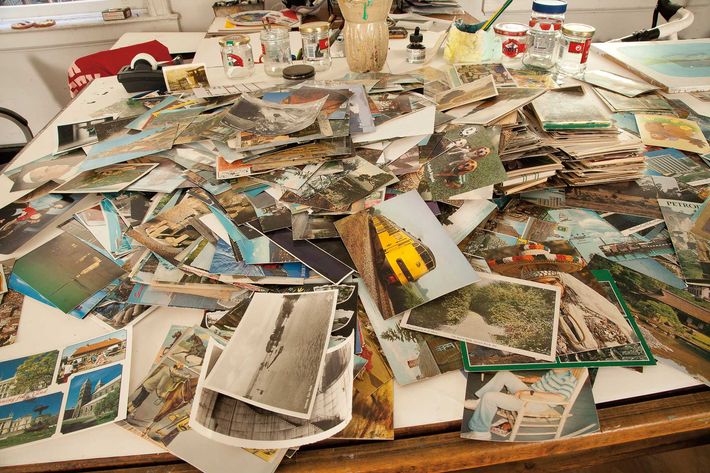
At the time of our visit, Wegman was finishing a large body of paintings, each begun by attaching a postcard to the middle of the ground and then working outward, inventing the rest of the scene. Wegman had a massive collection of postcards.
I asked him if his childrenÔÇÖs-book series was inspired by his own two children, Atlas and Lola. ÔÇ£I started them before I had kids, and then when I had kids, I decided that I didnÔÇÖt really want them to be so┬áwordy. You have to read them out loud! So I abridged several of them.ÔÇØ
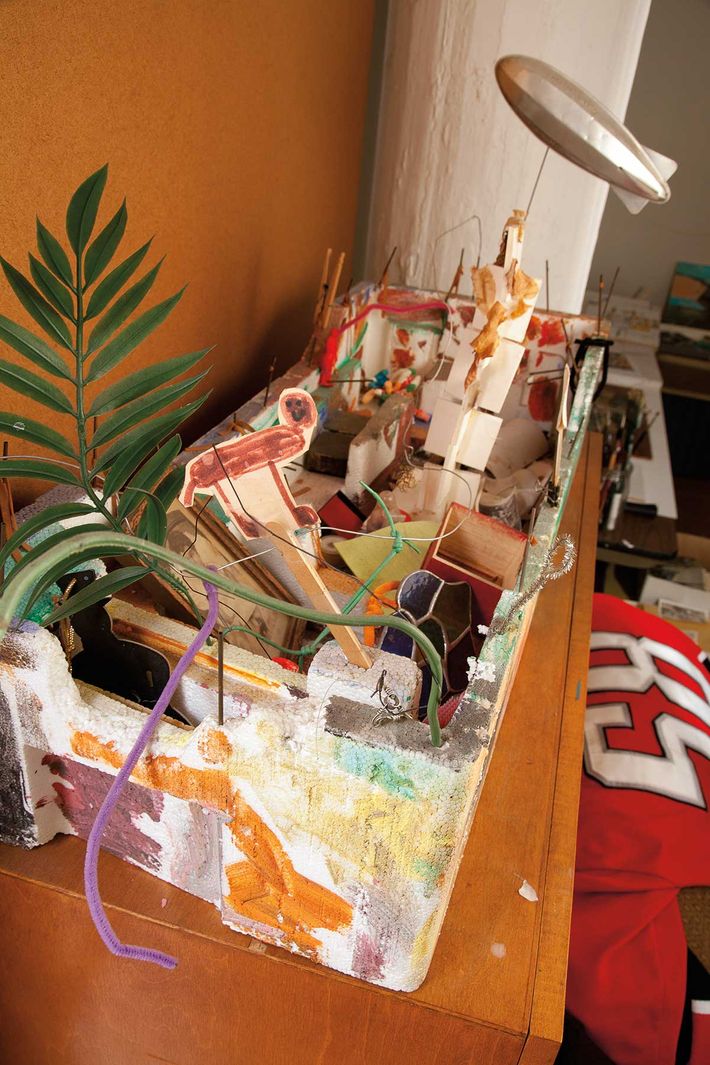
As we were talking, he pointed out a piece of packing foam behind me that he had painted and decorated with his then-3-year-old son. A purplish dog, no doubt a Weimaraner, was soaring in the air alongside what was either a blimp or missile above a house/metropolis. Wegman pointed out a few other cherished collaborations in Styrofoam, a four-wheeled vehicle carting around a modernist toothpick sculpture, and a series of drawings Wegman had made for his daughter that had supposedly come from the Tooth Fairy.
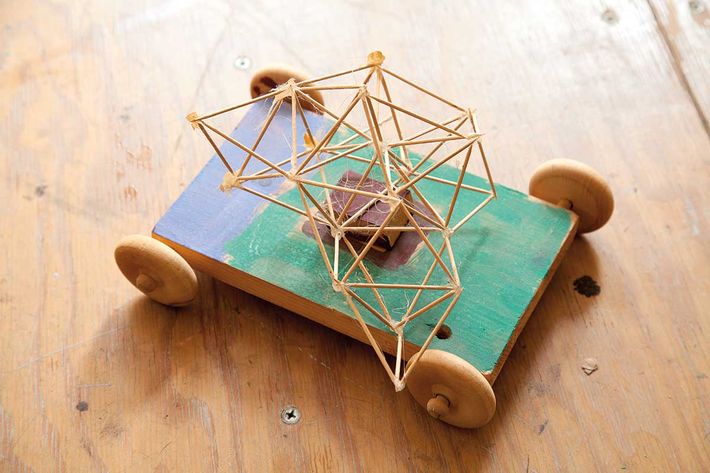
Wegman and I looked through several of his catalogues that included photographs taken at the Main Street studio now occupied by Saban. Despite their extremely minimal compositions, he could tell from cracks in the floor (from earthquakes in 1971 and ÔÇÖ72) that they had been taken there. He showed me a triptych in one of the catalogues of what appeared to be a falling chair (actually the same chair recropped three different ways).
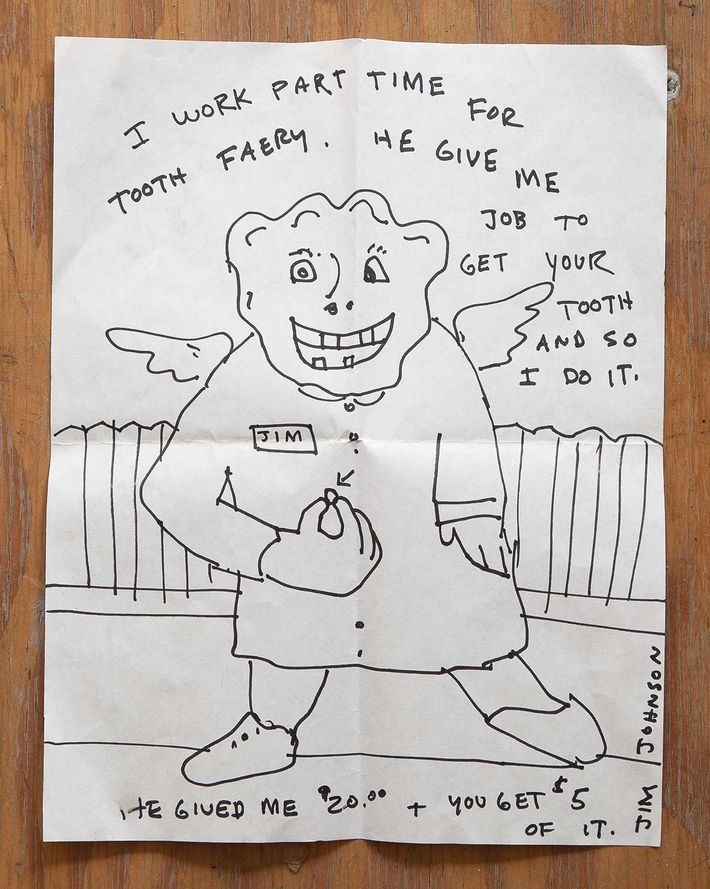
A lesser-known fact about Wegman is that he has been a lifetime player and enthusiast of hockey, playing four to five times per week. He became even more involved when his son started to play. Several shrines and assorted paraphernalia around the studio proved it.
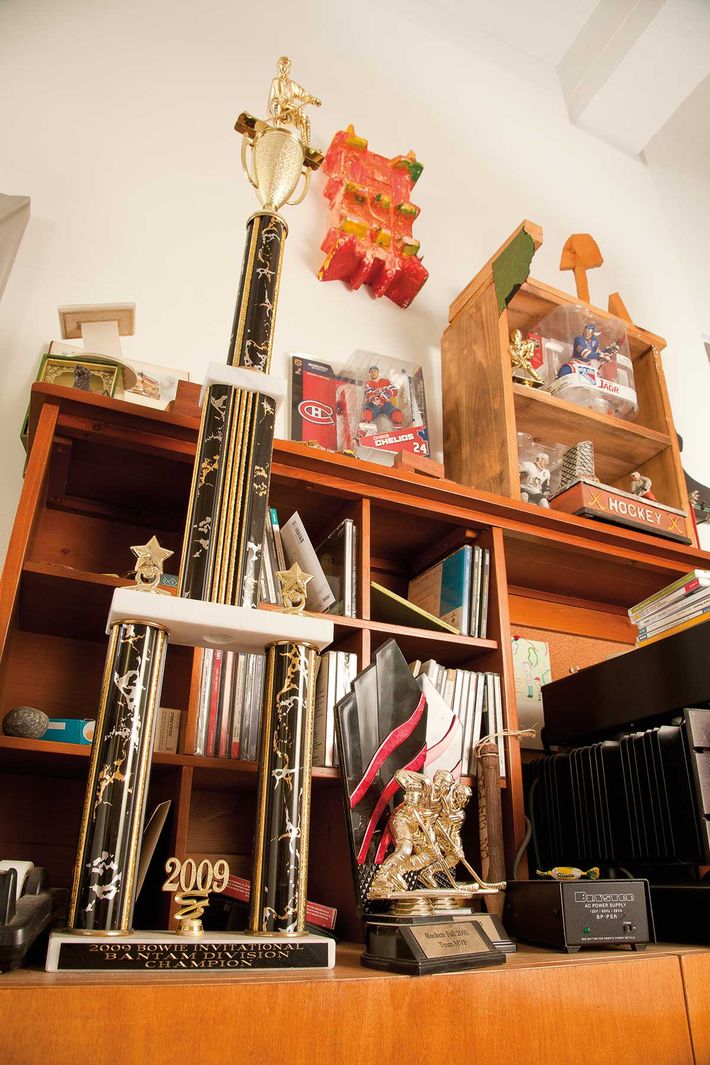
While I was shooting, I encountered a framed letter on the wall. ÔÇ£Bob and Ray. They were on Johnny Carson a bunch of times. TheyÔÇÖre old radio comics. Ray died, but Bob came to my retrospective, and I met them a few times when I was on TV. They were heroes of mine who influenced me, really funny.ÔÇØ
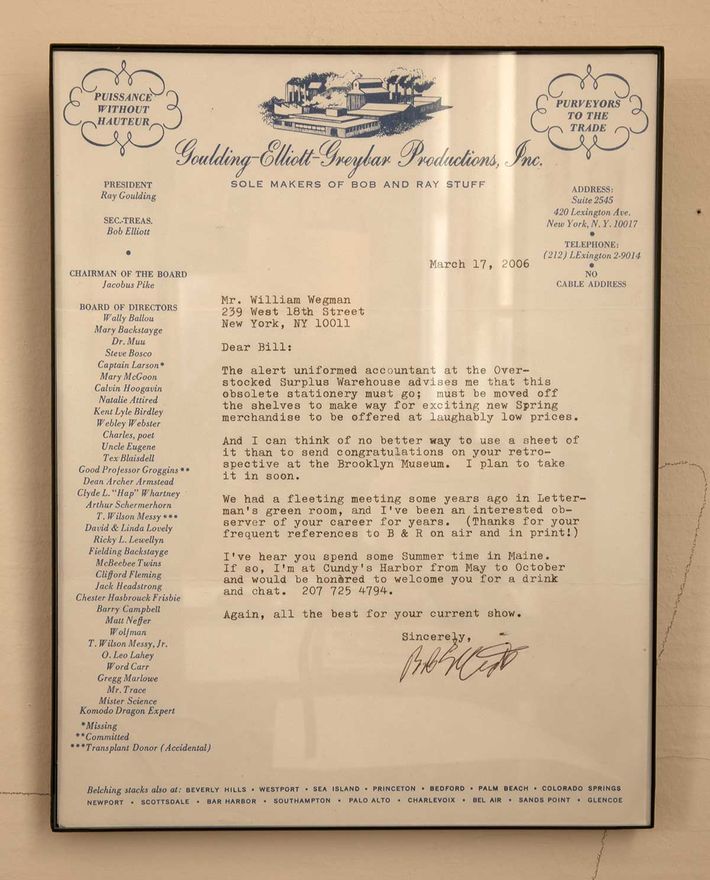
Toward the end of the shoot, Wegman and I were taking the freight elevator down when he mentioned the storage of all the dogsÔÇÖ costumes in the basement.
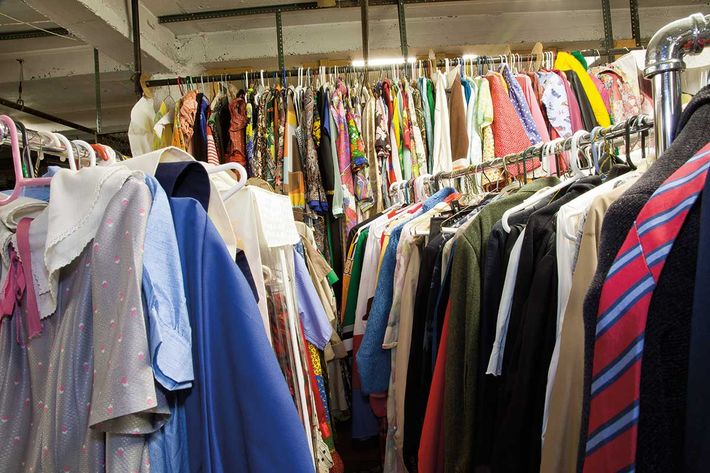
In one area was a stack of self-made stools ÔÇö devices to position his dogs within various frames throughout the years.
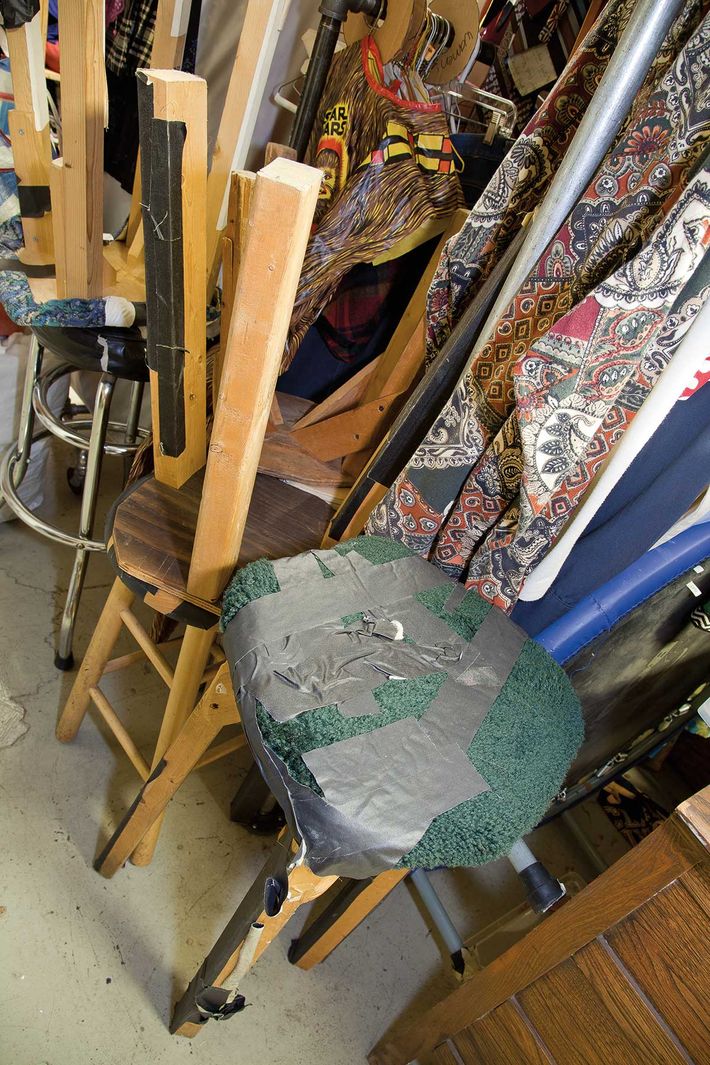
William WegmanÔÇÖs exhibition ÔÇ£Cubism and Other ÔÇôismsÔÇØ is on exhibition until January 10, 2015 at Senior & Shopmaker Gallery.
Excerpted with permission from┬áSTUDIO LIFE: Rituals, Collections, Tools, and Observations on the Artistic Process┬áby Sarah Trigg (Princeton Architectural Press, 2013). ┬® Sarah Trigg. All rights reserved. In 2009, Trigg, a visual artist,┬áembarked on an investigation within the United States, interviewing more than 200 artists in their studios. She met with a wide range of practitioners ÔÇö from painters to performance artists ÔÇö of various locations, backgrounds, and career stages to create a behind-the-scenes survey of artmaking today. Instead of focusing on artwork for the book,┬áTrigg asked her subjects to share examples from their practice that they considered to fall in the categories: mascots, collected objects, rituals, makeshift tools, residue, and habitats.


